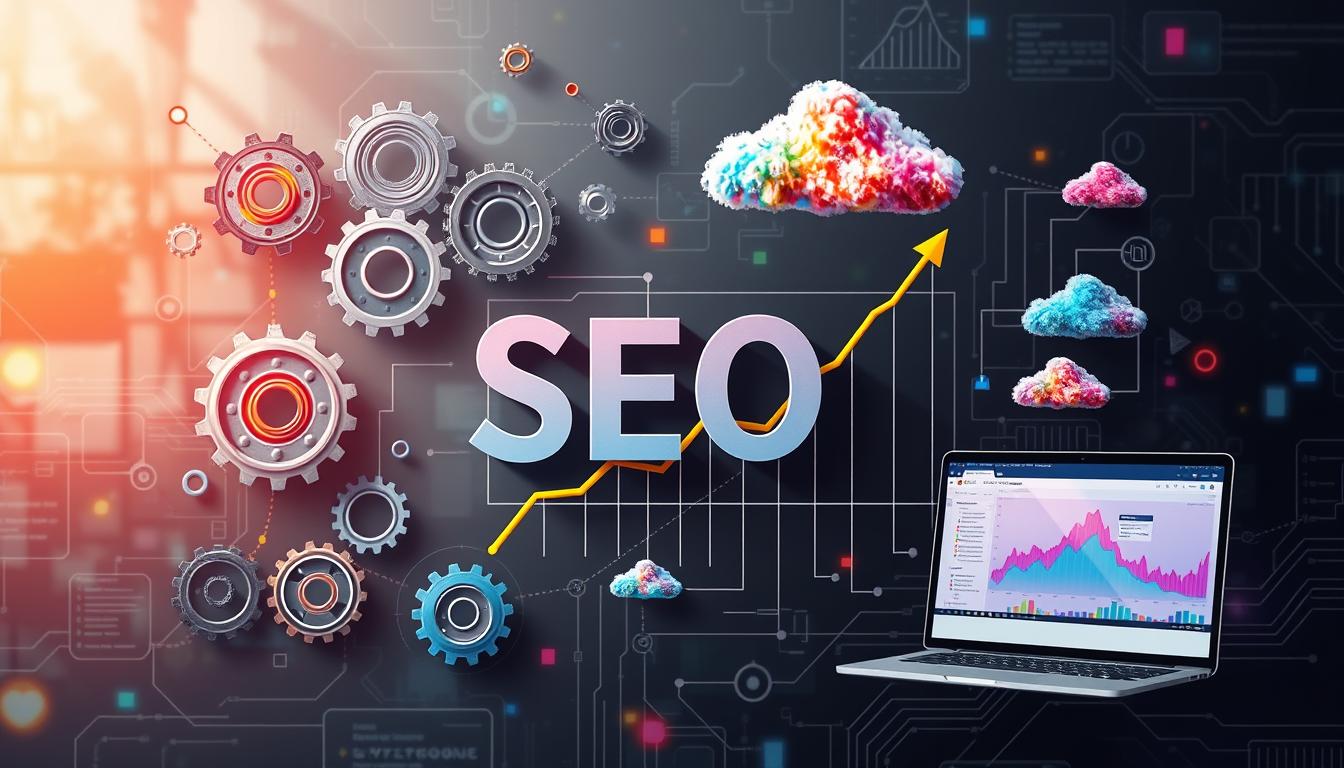In today’s digital landscape, the way we connect with audiences is evolving. With global internet usage skyrocketing, strategic content marketing has become a cornerstone for success. It’s not just about creating material; it’s about crafting experiences that resonate and drive action.
By 2025, ecommerce will be shaped by emerging technologies and consumer behaviors. Understanding these trends is crucial. Businesses that leverage SEO and data-driven strategies will stand out. They’ll turn casual readers into loyal customers.
Our approach is backed by real-world examples and industry insights. We’ll show you how to align your goals with your audience’s needs. Together, we’ll explore how to build a strong online presence that grows over time.
Key Takeaways
- Strategic content marketing drives ecommerce growth by 2025.
- Global internet trends shape consumer behavior and search habits.
- Well-crafted digital strategies turn readers into buyers.
- Understanding your audience is key to building a strong online presence.
- Data-driven approaches ensure long-term success.
Understanding the 2025 Ecommerce Landscape
The ecommerce landscape is undergoing a dramatic transformation as we approach 2025. With global retail sales projected to surpass $8 trillion by 2027, the digital marketplace is evolving faster than ever. Consumers are demanding more personalized and immersive experiences, and businesses must adapt to stay competitive.
Ecommerce Trends and Growth Projections
By 2025, several key trends will dominate the ecommerce space. One of the most significant is the rise of AI-driven personalization. Generative AI is expected to account for 10% of all product data produced, compared to just 1% in 2021. This technology allows businesses to create tailored recommendations, enhancing the shopping experience.
Another major trend is the growing influence of social media. Platforms like Instagram and TikTok are becoming essential for product discovery. In fact, 33% of B2B buyers now search for products on mobile devices and social platforms more than ever before.
“The future of ecommerce lies in creating authentic connections with consumers through personalized and immersive experiences.”
Key Technologies Shaping the Future
Emerging technologies are revolutionizing the way we shop. Artificial intelligence and machine learning are at the forefront, enabling businesses to analyze consumer behavior and predict trends. For example, 92% of businesses are already using generative AI to enhance the ecommerce experience.
Voice assistants and augmented reality (AR) are also gaining traction. By 2028, the number of voice assistant users in the U.S. will exceed 170 million, while the AR market is expected to grow to $723 billion by 2034. These tools are making shopping more interactive and convenient.
| Technology | Impact |
|---|---|
| AI and Machine Learning | Personalized recommendations, predictive analytics |
| Social Media | Product discovery, influencer marketing |
| Voice Assistants | Hands-free shopping, convenience |
| Augmented Reality | Immersive shopping experiences |
To stay ahead, businesses must embrace these technologies and adapt their strategies. For more insights on how content marketing trends are reshaping ecommerce, explore our detailed analysis.
Content Marketing for Online Businesses: Why It Matters
Building trust with customers starts with understanding their needs and preferences. In today’s competitive digital world, creating meaningful connections is essential. A well-crafted approach ensures your message resonates and drives action.

Understanding Your Audience
Knowing your audience is the first step to success. Surveys, social media interactions, and customer feedback are powerful tools. These methods help you gather insights into what your customers truly want.
For example, 70% of consumers feel closer to a company after reading its content. This shows the importance of tailoring your message to meet their expectations. By addressing their pain points, you build trust and loyalty.
Setting Clear Marketing Objectives
Clear goals are the backbone of any successful strategy. Whether it’s increasing engagement or driving sales, measurable objectives keep you on track. Aligning these goals with your audience’s needs ensures relevance and impact.
Studies show that companies with documented strategies achieve better results. For instance, 72% of marketers say that a strategic approach increases engagement. This highlights the value of planning and consistency.
| Strategy | Impact |
|---|---|
| Surveys and Feedback | Gathers direct insights into customer preferences |
| Social Media Engagement | Builds authentic connections and brand loyalty |
| Measurable Goals | Ensures focus and drives measurable results |
| Tailored Messaging | Resonates with the audience and builds trust |
By combining these strategies, you create a roadmap for success. Understanding your audience and setting clear goals are the keys to building a strong and lasting connection.
Exploring the Latest Ecommerce Technologies
Innovative tools are transforming the way ecommerce operates today. From AI-driven solutions to immersive media experiences, these advancements are reshaping how businesses connect with their audiences. Staying ahead in this fast-paced environment requires a deep understanding of emerging technologies and their applications.

Emerging Digital Tools
New digital tools are making it easier for businesses to engage with customers. For example, video content has become a powerful medium for storytelling. Platforms like TikTok and Instagram Reels are driving product discovery, with 33% of B2B buyers using these platforms to find new items.
Interactive tools like augmented reality (AR) are also gaining traction. AR allows customers to visualize products in real-time, enhancing their shopping experience. By 2034, the AR market is expected to grow to $723 billion, highlighting its potential.
Artificial Intelligence and Machine Learning Impact
AI and machine learning are revolutionizing ecommerce. These technologies enable businesses to analyze consumer behavior and predict trends. For instance, 92% of companies are already using generative AI to create personalized recommendations.
Voice assistants are another example of AI in action. By 2028, over 170 million users in the U.S. will rely on voice commands for shopping. This hands-free approach makes the process more convenient and efficient.
- AI-driven tools enhance personalization and customer engagement.
- Video and media platforms are essential for product discovery.
- AR and voice assistants create immersive and convenient shopping experiences.
- Staying updated with emerging technologies is crucial for success.
By leveraging these tools, businesses can create seamless and engaging experiences for their customers. The integration of AI and machine learning is not just a trend—it’s the future of ecommerce.
Customer-Centric Content Strategies
Understanding what your customers truly want is the foundation of any successful strategy. By focusing on their needs, we can create experiences that build trust and deliver real value. This approach ensures every interaction resonates with your audience and drives meaningful results.

Identifying Customer Expectations
To meet customer expectations, we must first understand them. Surveys, social media interactions, and feedback loops are powerful tools. For example, 70% of consumers feel closer to a company after engaging with its materials. This highlights the importance of listening and responding to their needs.
Actionable feedback helps us refine our strategies. By addressing pain points, we build trust and loyalty. Companies that prioritize customer experience generate 60% higher profits than their competitors. This shows the direct impact of a customer-first approach.
| Strategy | Impact |
|---|---|
| Surveys and Feedback | Gathers direct insights into customer preferences |
| Social Media Engagement | Builds authentic connections and brand loyalty |
| Personalized Experiences | Increases engagement and conversion rates |
| Solution-Driven Content | Builds trust and adds value |
By integrating these strategies, we create a roadmap for success. For more insights on optimizing your approach, explore our guide on mastering high-quality SEO techniques. Putting the customer at the center of your strategy is the key to lasting relationships and measurable growth.
Creating Valuable and Authentic Content
Crafting meaningful experiences starts with authenticity and value. In a world filled with noise, standing out requires more than just words. It demands a commitment to originality and relevance. We’ll explore how to create material that resonates and builds trust.
Storytelling is a powerful tool. It transforms facts into relatable narratives. For example, 70% of consumers feel closer to a company after engaging with its resources. This shows the impact of genuine communication.
Data-driven insights also play a crucial role. By analyzing trends and behaviors, we can craft material that meets audience needs. A study found that 76% of marketers prioritize quality over quantity. This highlights the importance of delivering real value.
| Strategy | Impact |
|---|---|
| Storytelling | Builds emotional connections and trust |
| Data-Driven Insights | Ensures relevance and accuracy |
| Originality | Helps stand out in a crowded space |
| Service-Oriented Approach | Addresses audience needs directly |
Innovation is key to staying ahead. As consumer preferences evolve, so should our approach. For instance, 54% of consumers want more video material from brands they support. This shows the need for constant adaptation.
By focusing on authenticity and value, we create material that not only informs but also inspires. It’s about building lasting relationships and driving meaningful results.
Engaging Your Audience through Social Media and SEO
Connecting with your audience in meaningful ways is essential in today’s digital age. By leveraging social media and SEO, we can create strategies that foster real connections and improve visibility. These tools are not just about reaching people—they’re about engaging them in ways that matter.

Social Media Tactics for Real Connections
Building genuine relationships starts with understanding your audience. On platforms like Instagram and TikTok, 81% of users research products and services. This shows the importance of creating shareable material that resonates.
Consistency is key. Posting regularly and engaging with comments builds trust. For example, 70% of consumers feel closer to a brand after positive interactions on social media. By listening and responding, we create authentic connections.
SEO Best Practices for Higher Visibility
Improving your SEO ensures your material is discoverable. With 93% of online experiences beginning with a search engine, optimizing for keywords and user intent is crucial. For instance, 72% of marketers say relevant material is the most effective SEO tactic.
Balancing quality with optimization is essential. Websites with blogs have 434% more indexed pages, driving organic traffic. By focusing on both value and technical SEO, we maximize reach and engagement.
| Strategy | Impact |
|---|---|
| Social Media Engagement | Builds trust and brand loyalty |
| Shareable Content | Increases visibility and reach |
| Keyword Optimization | Improves search rankings |
| Consistent Posting | Strengthens audience connection |
Blogging and Video Strategies for Impactful Content
Effective storytelling through blogs and videos can transform how audiences engage with your brand. These tools not only captivate but also build trust and authority. By combining them, we create a dynamic approach that resonates with our audience and boosts SEO rankings.

Generating Engaging Blog Topics
Creating fresh and relevant blog topics is key to keeping your website dynamic. For example, long-form posts are proven to improve SEO performance. Studies show that companies with active blogs receive 97% more inbound links, enhancing domain authority.
To generate ideas, focus on your audience’s pain points and interests. Surveys and social media interactions are great tools. A well-crafted blog can turn casual readers into loyal followers, driving measurable results.
Crafting Compelling Video Content
Videos are a powerful way to connect with your audience. Research shows that 53% of marketers consider video the most effective strategy. From how-to tutorials to testimonials, videos can humanize your brand and build trust.
For instance, explainer videos under three minutes are highly engaging. Platforms like YouTube and TikTok offer broad reach, making video a must-have in your strategy. By integrating storytelling, we create memorable experiences that drive action.
Integrating Visual Content Effectively
Combining blogs and videos creates a seamless experience. For example, embedding videos within blog posts increases time spent on your site. This not only boosts engagement but also improves SEO rankings.
Visual content like infographics and animations can simplify complex information. By aligning these tools with your brand’s message, we ensure consistency and impact. Together, they create a cohesive strategy that drives results.
“Blogging and video marketing are not just tools—they’re bridges to meaningful connections with your audience.”
- Blogging generates 3x more leads than paid advertising.
- Videos increase time spent on websites by up to six minutes.
- Combining blogs and videos enhances SEO and brand authority.
- Interactive tools like AR and animations create immersive experiences.
- Regular updates and audits keep your strategy fresh and effective.
By leveraging these strategies, we create a roadmap for success. Whether it’s through a well-written blog or a captivating video, the goal is to engage, inspire, and drive action.
Leveraging Email Marketing for Relationship Building
Email remains one of the most effective ways to connect with your audience. With an average ROI of $42 for every $1 spent, it’s a powerful tool for nurturing relationships and driving conversions. By focusing on personalization and segmentation, we can create campaigns that resonate deeply with our customers.
Growing and Segmenting Your Email List
Building a robust email list starts with offering value. For example, 81% of small businesses rely on email as their primary channel for acquiring customers. Segmentation is key—targeted emails can increase revenue by up to 760%. By categorizing your list based on interests or behaviors, you ensure your messages are relevant and engaging.
Designing Newsletters That Convert
Well-designed newsletters are essential for driving traffic and conversions. Emails with personalized subject lines have a 26% higher open rate. Compelling CTAs can boost click-through rates by 371%. Focus on mobile-responsive designs, as they increase engagement by 15%.
| Strategy | Impact |
|---|---|
| List Segmentation | Increases relevance and engagement |
| Personalized Emails | Boosts open and click-through rates |
| Mobile-Responsive Design | Enhances user experience |
| Compelling CTAs | Drives higher conversions |
By integrating these strategies, we create email campaigns that not only engage but also build lasting relationships. For more insights, explore our guide on mastering high-quality SEO techniques.
Integrating Mobile Optimization with SEO Techniques
Mobile devices have become the primary gateway to the digital world. Over 60% of Google searches now occur on mobile, making it essential to optimize your website for these users. A seamless mobile experience is critical for SEO success and maintaining high rankings in search engine results.
Ensuring a Mobile-Friendly Experience
Creating a mobile-friendly website starts with responsive design. This ensures your site adapts to any screen size, providing a consistent experience. For example, 50% of mobile users abandon sites that take more than three seconds to load. Fast load times and intuitive navigation are key to retaining visitors.
Technical SEO plays a significant role in mobile optimization. Features like larger, tappable buttons and simplified menus enhance user interaction. Optimizing images and multimedia content also improves load times, ensuring a smooth experience.
| Strategy | Impact |
|---|---|
| Responsive Design | Ensures consistency across devices |
| Fast Load Times | Reduces bounce rates and improves engagement |
| Simplified Navigation | Enhances user experience and retention |
| Optimized Media | Improves performance and accessibility |
By focusing on these strategies, we create a mobile-friendly experience that boosts SEO and drives traffic. For instance, websites optimized for mobile are 67% more likely to convert users into customers. This highlights the importance of aligning technical SEO with user needs.
Local search engine optimization is another critical factor. Over 80% of local searches on mobile devices lead to conversions. Features like Google My Business and location-specific keywords maximize visibility in mobile search results.
In conclusion, mobile optimization is not just a trend—it’s a necessity. By implementing these best practices, we ensure our website remains competitive and accessible in today’s mobile-first world.
Uncovering Future Growth Opportunities in Ecommerce
The future of digital commerce is being shaped by rapid advancements and evolving consumer behaviors. To stay competitive, businesses must identify and leverage emerging trends. By focusing on innovation and strategic planning, we can unlock new opportunities for growth.
Trends to Watch in Digital Commerce
Several trends are signaling potential growth opportunities. For instance, generative AI is transforming how consumers interact with products. By 2025, 27% of consumers expect AI to enhance real-time deal comparisons and search results.
Personalization is another key driver. Over 67% of consumers desire tailored interactions, and 71% want customized recommendations. Meeting these expectations can lead to higher engagement and loyalty.
- Generative AI improves product discovery and customer experience.
- Personalized interactions build trust and drive conversions.
- Retail media networks are growing faster than traditional advertising channels.
Technological Advancements Driving Change
Emerging technologies are revolutionizing the ecommerce landscape. AI and machine learning enable businesses to analyze consumer behavior and predict trends. For example, 92% of companies are already using generative AI to create personalized recommendations.
Augmented reality (AR) is also gaining traction. By 2034, the AR market is expected to grow to $723 billion. This technology allows customers to visualize products in real-time, enhancing their shopping experience.
“The integration of AI and AR is not just a trend—it’s the future of ecommerce.”
To achieve these results, businesses must set clear goals and foster collaboration within their teams. A strong marketing strategy ensures alignment with consumer needs and market trends.
By embracing these advancements, we can create innovative approaches that drive long-term success. Experimentation and adaptability are key to staying ahead in this dynamic landscape.
Conclusion
To thrive in today’s competitive digital world, integrating effective strategies is essential. We’ve explored how combining social media marketing, SEO, and customer-focused approaches can drive growth. These methods help build trust and deliver measurable results.
One key point is understanding your audience. Studies show that personalized interactions and engaging posts significantly boost loyalty. By focusing on their needs, you create experiences that resonate and convert.
Another critical takeaway is the importance of consistency. Regular updates and data-driven insights ensure your efforts remain relevant. Whether it’s a blog or a video, every word should add value.
We encourage you to implement these actionable tips and continue learning from industry studies. A well-rounded strategy is the foundation for long-term success. Share your thoughts and experiences to further the conversation around innovative approaches.
By following these steps, you can build a strong presence and achieve your goals. Let’s work together to create meaningful connections and drive growth.



